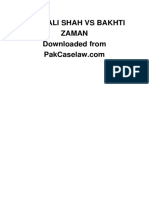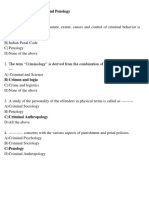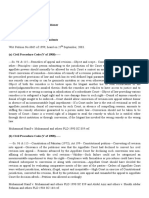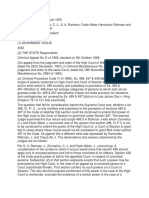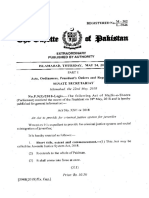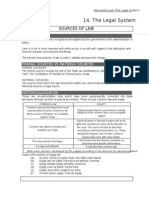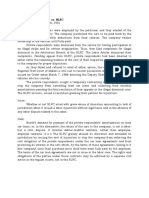LAW 471-CPC - Civil Procedure Code-09
LAW 471-CPC - Civil Procedure Code-09
Uploaded by
Mehmood AslamCopyright:
Available Formats
LAW 471-CPC - Civil Procedure Code-09
LAW 471-CPC - Civil Procedure Code-09
Uploaded by
Mehmood AslamOriginal Title
Copyright
Available Formats
Share this document
Did you find this document useful?
Is this content inappropriate?
Copyright:
Available Formats
LAW 471-CPC - Civil Procedure Code-09
LAW 471-CPC - Civil Procedure Code-09
Uploaded by
Mehmood AslamCopyright:
Available Formats
CIVIL PROCEDURE CODE COURSE OUTLINE
COURSE DESCRIPTION According to Sir John Salmond the Law of procedure may be defined as that branch of the law which governs the process of litigation. It is the law of actions and include all legal proceedings whether civil criminal. In Pakistan the law which governs the civil procedure is the Code of Civil Procedure (Act of 1908) which was enacted on 21st March 1908 and is a Consolidating and amending statute. The first Code of the Civil Procedure was enacted in 1859 and was amended in 1860, 1861 and 1874. The second code was enacted in 1882 which was amended in 1882, 1888, 1892, 1894 and finally in 1895. The present Code applies to all courts of Civil jurisdiction except excluded by High Court Rule and Orders and Supreme Court in its Civil Original and Appellate jurisdiction. By Central Laws (Statute Reforms) Ordinance, 1960 the Code has been extended to the whole of Pakistan. The Code is primarily a procedural law though it contains substantive provisions. The Code is divided in two parts containing sections which deal with the substantive law and the second parts contains rules which govern the procedure for exercise of the rights under civil jurisdiction. The Code regulates the civil proceedings and the nature of proceedings is not necessarily dependent upon the nature of jurisdiction of the court involved and a proceeding involving the assertion of a civil right is a civil proceeding. PURPOSE The purpose of the course is to acquaint the students with the substantive as well procedural provisions of the Code of Civil Procedure in particular with reference to the different stages of civil trial, judgment and decree and its execution, the right of exercise of appeal, revision and review. The course also focuses on the rigors of the procedure and how the same are employed at different stages by the litigant to defeat the ends of justice by delaying the outcome of litigation. REQUIRED TEXT 1. 2. 3. Code of Civil Procedure, 1908. Access to Justice in Pakistan by Justice Fazal Karim Cases on Pleadings and Procedure by Louisell Hazard and Tait
LECTURES There would be 24 lectures of _____ minutes each. GRADING Class Participation Quiz Mid Term Attendance 20% 10% 30% 10%
Final Exam
30%
Session 1 The Civil Process The purpose of Civil Litigation and Separation of Civil and Criminal work The meaning of the term Civil-PLD 1996 SC 543 The analysis of the Paragraph from the Charles Dickens Book Bleak House on the Jarndyce v Jarndyce Hamood ur Rehman Commission Report on Civil Justice Delay (1973) Woolf Report in England about the reforms in the Civil Litigation
Session 2 Civil Courts Structure in Pakistan The Civil Courts-Establishment-Article 175 of the Constitution Civil Courts Ordinance, 1962 Section 3 of the Ordinance, 1962 Court of District Judge Court of Additional District Judge The Court of Civil Judge The court of small causes established under the Provincial Small Causes Courts Act 1887 Any other Civil Court established under any other enactment. The High Court in exercise of Civil Jurisdiction is not a civil Court-PLD 1970 SC 1 District Court-Section 5 of the Ordinance Additional District Courts-Section 6 of the Ordinance Courts of Civil Judges-Sections 8 and 10 of the Ordinance Courts under Provincial Small Causes Courts Act, 1887-Section 11 of the Ordinance Special Courts enacted under Special Laws. Code of Civil Procedure Act 1908-an Introduction The Code is of general application-PLD 1965 Lahore 183 The Courts enforcing civil laws are courts of general jurisdiction-PLD 1996 SC 543 Part I of the Code-Sections 1-158 Part II of the Code-Orders 1-50 Article 202 of the Constitution of Pakistan providing for framing of rules in the High Court. Part X provides for the procedure by which rules in First Schedule may be amended or annulled. The extent of the Code Applicable in entire Pakistan Applicable to all civil proceedings-PLJ 1975 SC 25 & PLD 1947 PC 279 The distinction between substantive and Procedural laws PLD 1969 SC 187
Session 3 Jurisdiction of Civil Courts-Section 9 of the Code
Pecuniary Jurisdiction-Classes of Civil Courts under Civil Courts Ordinance, 1962 Court of Civil Judge III class Court of Civil Judge II Class Court of Civil Judge I Class The case to be instituted in the Court of the lowest gradeTerritorial Jurisdiction-Sections 16-21 of the Code Pecuniary Jurisdiction- Civil Courts Ordinance 1962 Place of Suing-Sections 16 and 17 of the Code Cause of action-Sections 16 and 17 of the Code Suits against Corporations PLD 1976 Lah 1233 PLD 1955 Lah 88 1991 SCMR 2030 Place of Suing where appellate order is made AIR 1934 PC 164 PLD 1974 SC 109 PLD 1968 SC 387 Agreement as to choice of forum 1992 SCMR 1174 Effect of no objection to pecuniary or territorial jurisdiction PLD 1959 Kar 669 Session 4 Express or Implied Ouster of Jurisdiction-Bar to the Suit Exceptions to the section 9 of the Code Res judicata-Section 11 of the Code and Explanations I to VI 1981 SCMR 878 AIR 1924 PC 202 1923 ALL ER 206 Conditions for application of Res judicata Foreign Judgment as Resjudicata Section 2(6) of the Code and Section 13 ibid The presumption that the Foreign judgment is by court of competent jurisidiction-Section 14 Where Section 11 is not applicable general principles are applicable-PLD 1982 SC 146 1981 SCMR 878 Suits barred by Section 12 CPC Sub section 1 of Section 12 where rules preclude filing of fresh suit the same is barred. The following rules bar fresh suit Order II Rule 2 CPC PLD 1948 PC 131 Order 9 Rule 9 CPC Order 21 Rule 103 Order 22 Rule 9 Order 33 Rule 1 CPC
Subsection 2 of Section 12 Where order, decree challenged on the ground of misrepresentation, fraud and want of jurisdiction fresh suit is barred Fraud-1993 SCMR 710 Misrepresentation Want of Jurisdiction Order and Decree can be challenged by an person-1984 SCMR 586 Session 5 Suits barred by Section 47 and Order 21 Rule 103 CPC Section 47-all proceedings arising in execution to be decided by executing court The meaning of the word decree-section 2(2) CPC PLD 1982 Lah 584 PLD 1977 Kar 273 Suit barred under section 144 CPC 1995 SCMR 584 Express Ouster of Jurisdiction Under Special Laws-PLD 1960 SC 113 PLD 1963 Lah 390 PLD 1965 SC 671 1979 1 All ER 365 Implied Ouster AIR 1940 PC 105 1959 3 ALL ER 1 PLD 1963 SC 704 PLD 1966 SC 1 Session 6 Power to Withdraw, transfer and Retransfer a Suit Sections 22, 23, 24 and 24A CPC PLD 1971 SC 247 PLJ 1974 Kar 322 Pleadings Generally Order 6 Rules 1 to 18 The meaning of Pleadings-Order 6 Rule 1 Pleadings other than Plaint and Written Statement Order 7 Rule 9 PLD 1985 Kar 95 Section 10 -Res Sub Judice-Principles Basic Rules of Pleadings Order 6 Rule 2 Order 6 Rule 14 Order 6 Rules 1 to 13
Address of Parties Order 4 Rule 2 Over 8 Rule 11 and 12 Order 7 Rule 26 Striking out, amending or altering pleadings Order 6 Rule 17 CPC PLD 1985 SC 345 Order 6 Rule 18 CPC Session 7 Commencing a Suit Section 26 CPC-A suit is commenced by filing plaint Order 4 Rule 1 Plaint part of pleadings-Orders 6 and 7 The plaint is to be in the prescribed form and contain certain particulars-Order 7 Rule 1 CPC Order 2 Rule 1 CPC- The plaint to contain the entire claim Order 2 Rule 2 CPC-The misjoinder and nonjoinder of causes of action The meaning of cause of action-the bundle of facts which the litigant has to prove The Parties to the Suit Order 1 CPC Order 1 Rule 1 CPC Order 1 Rule 2 CPC Order 1 Rule 3 CPC Representative Suit-Order 1 Rule 8 CPC Necessary and Proper parties-Order 1 Rule 10 CPC PLD 1975 SC 463 PLD 1994 SC 95 1985 SCMR 714 How the Party may appear and plead Order III CPC Power of Attorney
Session 8 Procuring the Presence of Defendant Summons to Defendant-Section 27 CPC & Order 5 Rule 1 The Summons-Order 5 Rules 3, 5 and 8 CPC Order 20 Rule 4 CPC
Service of Summons-Order 5 9-30 Order 5 R 17 CPC Order R 20 Order 5 R 30 Appearance and Non Appearance of Parties Order 9 R 1 CPC read with Order 17 Rule 2 CPC Order 9 R 3 empowers the Court to dismiss the suit when neither party appears when the suit is called for hearing The remedy of the Plaintiff if the suit is dismissed Where Plaintiff appears and defendant does not appear I0 if summons have been served properly the court may proceed ex parte Ii) if it is not proved that the summons were served the court would direct fresh summons Iii) if it is proved that the summons was not served in time for the defendant to appear the court would adjourn the case for a future date-Order 9 Rule 6 CPC When the Plaintiff does not appear Order 9 Rules 8 and 9 CPC PLD 1981 SC 21 Setting Aside Ex parte Decree Order 9 Rule 13-Sufficient Cause for non appearance Date of hearing Meaning of hearing-Order 17 CPC PLD 1975 SC 678 Session 9 Defendants Defence and Set Off Order 8 Rule 1-Written Statement to be filed within 30 days Order 8 Rule 2-The Written Statement Effect of failure to file written statement Order 8 Rules 9 and 10 CPC Set Off Order 8 Rule 6 read with Order 20 R 19 CPC Pretrial or Interlocutory remedies The Interlocutory remedies Section 94 CPC The following common interlocutory remedies are available a) b) Order 38 Rr 1 to 4 CPC Order 38 Rr 5 to 12 CPC
c) d) e)
Order 39 Rr 1 to 5 Order 40 Rr 1 to 5 Make any other order as may appear to the court to be just and convenient
Session 10 Pre Trial Proceedings Meaning of Pre trial and object of the proceedings Returning the Plaint under Order 7 Rule 10 CPC 1995 SCMR 584 Rejection of plaint under Order 7 R 11 CPC Clause a where the plaint does not disclose cause of action Clause b and c where the relief claimed is under valued PLD 1984 SC 289 Sections 148 and 149 CPC read with section 28 of the Court Fee Act Clause d where the suit is barred under the law PLD 1990 Lah 222 Stage for rejecting the plaint Only plaint to be looked at while rejecting plaint Effect of rejecting plaint Session 11 Examination of the Parties and Admission of Facts and Documents The relevant law is Orders 10, 11 and 12 of the CPC read with Section 30 CPC Order 10 R 1 CPC requires that the Court shall ascertain from each party whether it admits or denies the allegation of fact. Order 10 R 2 the court can on its own suggest any question to the each party Order 11 Rules 1 to 12 relate to interrogatories and Rules 12, 13 and 20 pertain to the discovery of documents. Order 11 Rr 15 and 16 pertain to production of documents Rr 17 to 19 pertain to inspection of documents Order 13 CPC provide for production, impounding and return of documents. It requires that certain documents should be produced on the first hearing and also provide for effect of non production. Settlement of Issues Order 14 provide for framing of issues if the parties are in controversy over the facts and law. Order 14 R 15 provide for amendment or striking down of the issues. 1992 MLD 1439 PLD 1997 SC 308 Issue of law may be treated as preliminary issue Burden of Proof (Articles 117 to 129 of Qanun e Shahdat Order 1984
Session 12 Commencement of Trial The right to begin is of the Plaintiff -Order 17 R 1 CPC Adjournments-PLD 1969 SC 270 Orders 17 R 2 and R 3 PLD 1971 SC 434 PLD 1991 SC 1109 PLD 1966 SC 467 Evidence Evidence can be oral or documentary Regarding Documents Order 7 Rr 14 and 15 Order 7 R 16 Order 8 R 1 CPC and Order 13 R 1 CPC Discretion to receive evidence not produced or entered in time. PLD 1961 Lah 643 Regarding oral evidence Difference between call and produce NLR 1980 Civil Lah 723 Service on the witness through summons Courts power to require evidence to be given Order 16 R 20 CPC Evidence to be recorded in open court -Order 18 R 4 CPC Order in which evidence is recorded-Order 18 Rr 1 and 3 CPC Evidence to be recorded in presence of judge-Order 18 Rr 5, 13 and 14 CPC Session 13 A suit may be disposed off in the following ways:a) b) c) d) e) By returning the plaint By rejecting the plaint By withdrawal or abandonment By consent or compromise On merits after due consent
Withdrawal or abandonment Order 23 R 1 CPC With drawal with or without permission of the court-Order 23 R 1 Institution of fresh suit without complying with the terms of the withdrawal PLD 1959 SC 287
Disposal by consent or compromise Order 23 R 3 CPC Judgment and Decree Section 33 CPC-The Court after hearing the case shall pronounce judgment and decree. Time and stage for pronouncing judgment-Order 20 R 1 CPC The judgment to be signed and dated-Order 20 R 2 CPC The judgment to be pronounced within 30 days of hearing of the arguments Contents of the judgment Order 20 Rr 4 and 5 CPC The decree to follow judgment-Section 33 CPC and Order 20 R 6 CPC Session 14 Relief that may be granted by the Court Order 7 R 7 CPC PLD 1963 SC 382 PLD 1989 Kar 404 Relief as of right and discretion Costs Cost of the suit Sections 35, 35A and Order 25 CPC Meaning of Costs Compensatory Costs Security for Costs-Order 25 CPC Compensation under Section 95 CPC Decree for payment of money Decree for payment of money in foreign currency Payment of interest-Sections 34, 34-A and 34 B. Session 15 Execution of Decree The difficulties of litigant begin when he obtains decree Provisions for the execution of the Decree-Sections 36 to 74 and Order 21 CPC Commencement of Execution proceedings Application for execution is made under Order 21 R 10 CPC Requirement of Notice-Order 21 R 22 CPC The executing court cannot go behind decree 1994 SCMR 22 Modes for execution Section 51 CPC enumerates the modes in which the decree is to be executed
a) b) c) d) e)
by delivery of property specifically decreed by attachment and sale or by sale without attachment of any property by arrest and detention in prison by appointing receiver in such manner as the nature of the relief granted may require
The detailed procedure regulating the exercise of such powers is prescribed in Order 21 CPC Attachment and Sale Sections 60 -67 and Order 21 Rr 41 to 94 CPC Arrest and Detention Sections 55 to 58 and 136 CPC and Order 211 Rr 30, 31 and 37 to 40 CPC Appointing a Receiver Order 40 This is an equitable relief which is allowed on the ground that there is no effective remedy by execution at law. Any other manner includes the following Partition of the Property (Section 54) Execution of the decree by the collector (Sections 68 to 72) Compensation in lieu of movable property (Order 21 R 31) Specific Performance of agreement (Order 21 R 32) Restitution of conjugal rights (Order 21 R 33) Execution of documents (Order 21 R 53) Attachment of decree (Order 21 R 53)
Session 16 APPEALS Appeal against Judgment and Decree Appeal Against Orders Appeal against Judgment and Decree Section 96-Appeal to lie to the competent court against every decree passed by any court exercising original jurisdiction An appeal from exparte decree is maintainable No appeal would lie from decree passed with consent of the parties An appeal is a right to be conferred by statute 1984 CLC 2981 First appeal is on errors of facts and law and the entire case is reheard by the appellate court. The procedure to be followed in first appeal is provided in Order 41 The appeal is to be filed by drafting Memorandum of Appeal which have to be accompanied by Decree. (Order 41 Rr 1 and 2) The filing of appeal does not operate as stay to the execution proceedings (Order 41 R 5) The appellate court can order taking down of additional evidence (Order 41 R 27) Appeal is of right and is admitted for regular hearing (Order 41 R 9) however the court may dismiss the appeal without sending for the record of the lower court (Order 41 R 11)
Appellate Court to give notice to the court against whose decree appeal is entertained (Order 41 R 13) The appellant has the right to begin (Order 41 R 16) and may be dismissed for appellants default (Order 41 R 17) or may be dismissed where the appellant fails to deposit the service charges (Order 41 R 18) however the court has the power to readmit appeal dismissed for default Order 41 R 19 The respondent may also file cross objections -Order 41 R 22 The Appellate Court may remand the case or where the evidence is sufficient itself disposes it off or frames an additional issue and directs the trial court to take evidence on it and decide the case. (Order 41 Rr 23-26) Second Appeal -Sections 100 and 101 CPC Second Appeal lies on the question of law only 2000 SCMR 1873 No second appeal in cases arising from Small Cause Courts or where the subject matter in the original suit does not exceed 25000/- and in other cases where the original value does not exceed 250000/Power of High Court to determine issue of fact in second appeal-Section 103 CPC Appeals from Orders Section 104 and Order 43 R 1 CPC enumerates orders from which appeals would lie The procedure to be followed is the same as in Order 41 CPC Order 43 R 3 CPC notice is to be served at the time of filing appeal Sections 107 and 108 CPC provide for the orders that may be passed by the Appellate Courts and the procedure to be followed. Session 17 Revisions Section 115 CPC The High Court may call for the record of any case which has been decided by any court subordinate to such High Court and in which no appeal lies and in which the subordinate court appears to have a) exercised jurisdiction not vested in it by law b) have failed to exercise jurisdiction so vested c) to have acted illegally in exercise of its jurisdiction or with material irregularity The High Court may make such order as it thinks fit The District court can exercise this power as well If any person makes an application under this section the entire record of the case is to be appended. Revision lie against case decided 1985 CLC 2758 PLD 1964 L 101
PLD 1993 SC 109
The order should be by a court subordinate Section 3 defines subordination of courts No appeal should be maintainable against the order Record of he case Exercised Jurisdiction not vested in it 1999 YLR 2423 1984 CLC 948 1999 CLC 707 Failure to exercise jurisdiction vested PLD 1975 LAH 425 PLD 1967 SC 402 PLD 1975 SC 186 Exercise of jurisdiction illegally or with material irregularity 1989 SCMR 34 2001 SCMR 1700 2001 SCMR 67 PLD 1994 SC 162 Jurisdiction under section 115 CPC is supervisory and is discretionary The Court in revision may pass any order as it thinks fit 1999 SCMR 971 Session 18 Review Section 114 and Order 47 CPC provides for review A review lies against judgment or decree or order of the Court against the same court. The grounds on which review lies are contained in Order 47 R 1 CPC. The following are the grounds for review a) b) c) Discovery of new and important evidence which was not available earlier On account of error apparent on the face of record any other sufficient reason
Application for review to be made to the same court The provisions as to forms for appeal apply mutatis mutandis Order of rejection not appeal able-Order 47 R 7 No review against review-Order 47 R 9 Instances of errors meriting review AIR 1932 O 23
PLD 1991 SC 105 PLD 2003 SC 724 PLD 2003 Kar 145 PLD 1979 SC 741 AIR 1934 PC 213
Session 19 Summary Suits Order 37 CPC - Suits based on Negotiable Instruments Order 37 R 2 defines Negotiable Instruments Order 37 R 3 the summons sent to Defendant who has to obtain leave to defend from the court. Leave to Defend to be decided on affidavits PLD 1963 SC 103 Where no substantial question of law or fact shown no leave is to be granted 1999 SCMR 2832 Leave may be granted conditionally or unconditionally 2000 SCMR 95 A court should not refuse leave unless the defendant discloses no defence PLD 1996 SC 749 2004 SCMR 1747 2001 CLC 653 Decree passed under Order 37 R 3 may be set aside on such terms and conditions as the court thinks fit-Order 37 R 4 CPC The Court can order production of original bills etc-- Order 37 R 5 CPC Procedure in Suits-Order 37 R 7 CPC Session 20 Part 11 of the CPC provides for miscellaneous provisions Sections 132 to 158 Persons exempt from personal appearance Section 132-Women exempted from personal appearance Section 133-Govt. may by notification exempt certain persons from personal appearance in the court Exemption from Arrest Under section 135 a judge, a magistrate or any other judicial officer is exempt from arrest Section 135-A a member of legislature during the proceedings is exempt from arrest
Language of Court Sections 137 and 138 provides for the language of the Court Oath on affidavits Under S 139 oath on an affidavit may be administered to the deponent Section 141 CPC- CPC applies to other proceedings of civil nature PLD 1970 SC 1 PLD 1987 SC 512 PLD 1996 SC 543 Enforcement of liability of the surety-Section 14 CPC Session 21 Power to enlarge time-Section 148 CPC Inherent powers of the court to prevent the abuse of process of court and necessary for the ends of justice PLD 1975 SC 32 1972 SCMR 73 Ends of Justice, abuse PLD 1965 SC 287 Section 152 CPC-Correction of orders Section 144-CPC Restitution Session 22 Revision Session 23 Revision Session 24 Revision
You might also like
- MULLA On CPC PDFDocument2,712 pagesMULLA On CPC PDFADITYA SINGH100% (8)
- Pakistan Medical Commission Last Recognized Inspection Grades of Private Medical CollegesDocument9 pagesPakistan Medical Commission Last Recognized Inspection Grades of Private Medical CollegesKHALIL UR REHMAN TARIQNo ratings yet
- ALEXANDER JOLLIES: Consequences of Multi-Tier Arbitration Clauses: Issues of Enforcement", Reprinted From (2006) 72 Arbitration, P. 335Document3 pagesALEXANDER JOLLIES: Consequences of Multi-Tier Arbitration Clauses: Issues of Enforcement", Reprinted From (2006) 72 Arbitration, P. 335Shagun SinghalNo ratings yet
- Curriculum LAW GAT Test HECDocument1 pageCurriculum LAW GAT Test HECJawaid AkramNo ratings yet
- Taj Wali Shah VS Bakhti Zaman, 2019 Scmr-Supreme-Court 84 (2018)Document7 pagesTaj Wali Shah VS Bakhti Zaman, 2019 Scmr-Supreme-Court 84 (2018)Malik AsadNo ratings yet
- Unlawful Detainer Judicial AffidavitDocument3 pagesUnlawful Detainer Judicial AffidavitFelicia Allen86% (14)
- MCQs On Criminology and Penology 1Document30 pagesMCQs On Criminology and Penology 1Leo100% (19)
- 2017 S C M R 279 497Document1 page2017 S C M R 279 497Judicial AspirantNo ratings yet
- LAW 240-Criminal Law Outline 2010Document11 pagesLAW 240-Criminal Law Outline 2010fahimchaudharyNo ratings yet
- LAW 482-Moot Court-Ali QazilbashDocument4 pagesLAW 482-Moot Court-Ali QazilbashAsif MasihNo ratings yet
- Course Outline - LAW 352 - Public International Law - Ali Sultan - Fall 2019Document5 pagesCourse Outline - LAW 352 - Public International Law - Ali Sultan - Fall 2019Momal100% (1)
- Presentation On Section 397 of CRPCDocument19 pagesPresentation On Section 397 of CRPCkashifNo ratings yet
- Business Law. Course Outline. Fall 2019. Morial ShahDocument9 pagesBusiness Law. Course Outline. Fall 2019. Morial ShahAaliyan BandealyNo ratings yet
- 12 (2) CPCDocument7 pages12 (2) CPCShikkari HunterNo ratings yet
- Course Outline Muslim Personal LawDocument13 pagesCourse Outline Muslim Personal LawQasim OdhiamboNo ratings yet
- Law 220-Contract Law-Khyzar HussainDocument21 pagesLaw 220-Contract Law-Khyzar HussainMuhammad Irfan RiazNo ratings yet
- Interpretation of StatutesDocument68 pagesInterpretation of StatutesKhushhal KhanNo ratings yet
- Section 164, 364 & 533Document20 pagesSection 164, 364 & 533wasim ahmedNo ratings yet
- LAW 220-Contract Law-Zubair Abbasi PDFDocument12 pagesLAW 220-Contract Law-Zubair Abbasi PDFShakeel AkhundNo ratings yet
- 2004 PLD 17 Lahore-High-Court-LahoreDocument3 pages2004 PLD 17 Lahore-High-Court-LahoreAdv Sohail BhattiNo ratings yet
- The Supreme Court of BangladeshDocument51 pagesThe Supreme Court of BangladeshSesh Bikeler MeyeNo ratings yet
- Civil Judge SalybsDocument19 pagesCivil Judge SalybsTariq VirkNo ratings yet
- Chanakya National Law UniversityDocument3 pagesChanakya National Law UniversityAishwarya ShankarNo ratings yet
- Syed MunawarDocument102 pagesSyed MunawarShehyar AliNo ratings yet
- LAW 322-Labor Law-Muhammad AzeemDocument22 pagesLAW 322-Labor Law-Muhammad AzeemNimraNo ratings yet
- Final Curriculum LLB (Law) - HECDocument66 pagesFinal Curriculum LLB (Law) - HECJeshurun Joseph0% (1)
- Curriculum LAW GAT TestDocument2 pagesCurriculum LAW GAT TestMajid MengalNo ratings yet
- Curriculum LAW GAT TestDocument2 pagesCurriculum LAW GAT TestIkramuddin KamilNo ratings yet
- Trail Procedure Family Law Part 1&2Document3 pagesTrail Procedure Family Law Part 1&2n9b59tzm2gNo ratings yet
- Syllabus-LLB Part 1Document9 pagesSyllabus-LLB Part 1Hassan Bokhari100% (2)
- The Code of Civil Procedure - Notes McqsDocument4 pagesThe Code of Civil Procedure - Notes McqsLubnaNo ratings yet
- Law 240-Criminal Law-Khalil-ur-Rehman RamdayDocument12 pagesLaw 240-Criminal Law-Khalil-ur-Rehman RamdayAbdullah BhattiNo ratings yet
- Limitations Act 1908Document16 pagesLimitations Act 1908mahasina bannaNo ratings yet
- 2nd IntimationDocument15 pages2nd IntimationAbdul BasitNo ratings yet
- What Is Constitution? - Rehan Aziz Shervani - Cell# 0333-4324961Document5 pagesWhat Is Constitution? - Rehan Aziz Shervani - Cell# 0333-4324961Rehan Shervani100% (2)
- Indian Penal CodeDocument3 pagesIndian Penal Codearp_patel88100% (1)
- Lecture 13 CPC - PRE TRIAL PROCESSDocument29 pagesLecture 13 CPC - PRE TRIAL PROCESSPraveena raviNo ratings yet
- Law Gat DefinitionsDocument10 pagesLaw Gat Definitionshamad shahNo ratings yet
- Laws For The Labours of PakistanDocument44 pagesLaws For The Labours of PakistanSono Malik75% (4)
- LLB Notes-Part-I Criminal Law: Course ContentsDocument2 pagesLLB Notes-Part-I Criminal Law: Course ContentsZahid KhanNo ratings yet
- PLD 1966 Supreme Court 1003Document5 pagesPLD 1966 Supreme Court 1003Anum AkramNo ratings yet
- LAW 223 - Commercial Law - Uzair J KayaniDocument9 pagesLAW 223 - Commercial Law - Uzair J KayaniHaris AliNo ratings yet
- CPCDocument4 pagesCPCMrudula GaneshNo ratings yet
- Khan Asfandyar Wali NAB SummaryDocument10 pagesKhan Asfandyar Wali NAB SummaryLaiba ShoaibNo ratings yet
- West Pakistan Land Revenue RulesDocument112 pagesWest Pakistan Land Revenue RulesgladiatorranaNo ratings yet
- Punjab Rented Premises ActDocument3 pagesPunjab Rented Premises Actwhatsapp funny vediosNo ratings yet
- Muslim Personal LawDocument52 pagesMuslim Personal LawYousaf NaeemNo ratings yet
- Indian Penal Code PDFDocument11 pagesIndian Penal Code PDFguru vishnuguptaNo ratings yet
- Offences Against Property Ordinance 1979Document9 pagesOffences Against Property Ordinance 1979lovesyndromeNo ratings yet
- Government of Bangladesh VsDocument3 pagesGovernment of Bangladesh VsTauky YasirNo ratings yet
- Fehmida (CRIMINAL LAW)Document14 pagesFehmida (CRIMINAL LAW)جواد کریمNo ratings yet
- Notes Criminal Procedure by Zahid Hussain Channa-1Document39 pagesNotes Criminal Procedure by Zahid Hussain Channa-1Muhammad Naeem100% (2)
- Juvenile Justice System Act, 2018 PDFDocument13 pagesJuvenile Justice System Act, 2018 PDFNouman JahangirNo ratings yet
- The Legal SystemDocument5 pagesThe Legal SystemUmer EhsanNo ratings yet
- LLB PapersDocument8 pagesLLB PapersKamil QaddusNo ratings yet
- QSO McqsDocument15 pagesQSO McqsFahadkhanNo ratings yet
- Zulfiqar Comments)Document2 pagesZulfiqar Comments)api-3745637No ratings yet
- COGNIZANCE (Sec 190 To Sec 199) : ShardaDocument18 pagesCOGNIZANCE (Sec 190 To Sec 199) : ShardaRohit GargNo ratings yet
- The 1 Uol National Moot Court Competition-2019: Team Code-J1Document23 pagesThe 1 Uol National Moot Court Competition-2019: Team Code-J1Ahsan Ali ButroNo ratings yet
- LLB 1 AssignmentDocument11 pagesLLB 1 AssignmentSuhaib Ajmal Ziai100% (2)
- Pakistan Penal CodeDocument2 pagesPakistan Penal CodeSalman Ali MastNo ratings yet
- The Pakistan Supreme CourtDocument121 pagesThe Pakistan Supreme CourtAdnan S JavedNo ratings yet
- Piatt v. AbordoDocument2 pagesPiatt v. AbordoAlvinson DayritNo ratings yet
- Stolt-Nielsen Transportation Group, Inc. v. MedequilloDocument1 pageStolt-Nielsen Transportation Group, Inc. v. MedequilloGia DimayugaNo ratings yet
- United States v. Brandon Keith Gallander, 11th Cir. (2015)Document6 pagesUnited States v. Brandon Keith Gallander, 11th Cir. (2015)Scribd Government DocsNo ratings yet
- Agustines Vs CFIDocument5 pagesAgustines Vs CFIchikayNo ratings yet
- Codal - Obligations and ContractsDocument2 pagesCodal - Obligations and ContractsJanzel SantillanNo ratings yet
- United States v. Kirtman, 10th Cir. (1999)Document8 pagesUnited States v. Kirtman, 10th Cir. (1999)Scribd Government DocsNo ratings yet
- BHOONAH J V MAURITIUS REVENUE AUTHORITY 2017 SCJ 53Document5 pagesBHOONAH J V MAURITIUS REVENUE AUTHORITY 2017 SCJ 53Jonathan BruneauNo ratings yet
- Final Reply Motion To Sanction PDFDocument151 pagesFinal Reply Motion To Sanction PDFNausheen Zainulabeddin100% (1)
- Valdez vs. Court of AppealsDocument6 pagesValdez vs. Court of AppealsaudreyNo ratings yet
- John N. Wittekamp v. Gulf & Western, Inc. Gulf & Western Industries, Inc. Gulf & Western Manufacturing Co. and Wickes Manufacturing John N. Wittekamp, 991 F.2d 1137, 3rd Cir. (1993)Document13 pagesJohn N. Wittekamp v. Gulf & Western, Inc. Gulf & Western Industries, Inc. Gulf & Western Manufacturing Co. and Wickes Manufacturing John N. Wittekamp, 991 F.2d 1137, 3rd Cir. (1993)Scribd Government DocsNo ratings yet
- Legislative Department: Marrie Angela D. SantiagoDocument46 pagesLegislative Department: Marrie Angela D. SantiagowestphaliaNo ratings yet
- Cicero Court Notice of Appeal, Statement & Exhibits (Case No. 15031380) Filed DA'S Office Jan 8, 2016 (10 PP)Document10 pagesCicero Court Notice of Appeal, Statement & Exhibits (Case No. 15031380) Filed DA'S Office Jan 8, 2016 (10 PP)Desiree YaganNo ratings yet
- Office of The President VS BuenaobraDocument2 pagesOffice of The President VS BuenaobraLuz Celine CabadingNo ratings yet
- USA V Teixeira Motion Detention Notice of AppealDocument29 pagesUSA V Teixeira Motion Detention Notice of AppealFile 411No ratings yet
- Punjab Courts ActDocument11 pagesPunjab Courts ActHunney MittalNo ratings yet
- A Compendium of Mortgage CasesDocument54 pagesA Compendium of Mortgage CasesCarrieonicNo ratings yet
- LAW 3100 - Persons & Family Relations - JD 55. G.R. No. 199601 - BDO vs. Gomez - Full TextDocument5 pagesLAW 3100 - Persons & Family Relations - JD 55. G.R. No. 199601 - BDO vs. Gomez - Full TextJOHN KENNETH CONTRERASNo ratings yet
- Numeriano F. Capangpangan For Petitioner. Meinrado P. Parades For Private RespondentsDocument4 pagesNumeriano F. Capangpangan For Petitioner. Meinrado P. Parades For Private RespondentsAnonymous MmbSn3No ratings yet
- Ermidia A Mariano Vs Royal Interocean Lines Et Al PDFDocument3 pagesErmidia A Mariano Vs Royal Interocean Lines Et Al PDFReen DosNo ratings yet
- Excessive Delegation: 5.4 Administrative LawDocument10 pagesExcessive Delegation: 5.4 Administrative Lawdivyanshu singhNo ratings yet
- JG SUMMIT HOLDINGS v. COURT OF APPEALS, ET AL.Document2 pagesJG SUMMIT HOLDINGS v. COURT OF APPEALS, ET AL.Groggy MorganfreeNo ratings yet
- Motion To Release Impounded VehicleDocument3 pagesMotion To Release Impounded VehicleHR Legal100% (1)
- Memorandum of Plea Agreement, USA Vs Jacob L. Smith, November 6, 2020.Document30 pagesMemorandum of Plea Agreement, USA Vs Jacob L. Smith, November 6, 2020.Ian LindNo ratings yet
- Transicript of Bexar County Hearing With Judge Michael MeryDocument41 pagesTransicript of Bexar County Hearing With Judge Michael MeryBexarCo100% (1)
- Senarillos V Hermosisima (1956)Document2 pagesSenarillos V Hermosisima (1956)Reyna RemultaNo ratings yet
- Nestlé Philippines, Inc. vs. NLRCDocument1 pageNestlé Philippines, Inc. vs. NLRCPNP MayoyaoNo ratings yet
- 167923-2013-Heirs - of - Ignacio - v. - Home - Bankers - Savings - andDocument11 pages167923-2013-Heirs - of - Ignacio - v. - Home - Bankers - Savings - andMilane Anne CunananNo ratings yet
- IN Disciplinary Proceedings: Wasimul HaqDocument70 pagesIN Disciplinary Proceedings: Wasimul HaqAnand DubeyNo ratings yet




